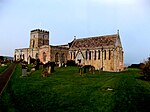Waren (port)
BamburghPorts and harbours of Northumberland

Waren, also known as Warn, Waren Bay, Warenmouth and Warenquay, was a seaport at Budle Bay, on the north-east coast of England, the recorded history of which spans from the 1240s to the early twentieth century. Waren was England's northernmost mainland port during periods in which Berwick Upon Tweed was controlled by the Kingdom of Scotland. The port was associated with Bamburgh and its castle, situated 1.5 miles (2.4 km) to the east-south-east.
Excerpt from the Wikipedia article Waren (port) (License: CC BY-SA 3.0, Authors, Images).Waren (port)
B1342,
Geographical coordinates (GPS) Address Nearby Places Show on map
Geographical coordinates (GPS)
| Latitude | Longitude |
|---|---|
| N 55.615129 ° | E -1.747777 ° |
Address
B1342
NE69 7AJ
England, United Kingdom
Open on Google Maps





